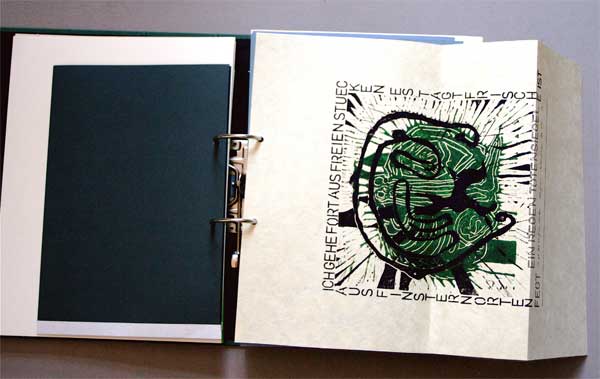
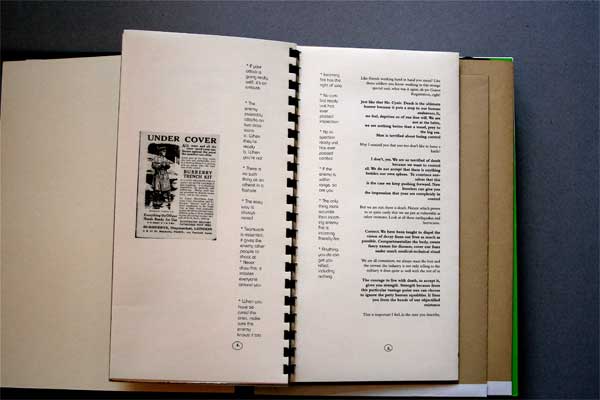
Dear fellow Borges enthusiasts,
We would like to take this opportunity to introduce you to our project the Zweite Enzyklopädie von Tlön.
In a five year project our core group of two graphic artists, a journalist and a writer will attempt to rediscover Borges second encyclopaedia. The Borges short story Tlön, Uqbar, Orbis Tertius weaves like a loose thread through our work.
The idea of a lost society whose last remaining cultural imprint is a structured yet surreal encyclopaedia...echoes through our work. To give you a more concrete impression of our encyclopaedic project here is an outline of what our work is: In its entirety our encyclopaedia will consist of books, original texts and art works. Within this medium words and images become interchangeable. They in turn are filed into five folders which are in alphabetical order. We chose folders not only because they allow us the maximum amount of freedom for the entries we are producing, in size and type, but also because no permanent order is dictated.
In the five years we intend to invite guests to either produce books, original works or provide us with texts. The encyclopaedia so far has been bought by the Victoria & Albert Museum, the Herzog August Bibliothek, the Museum Meermanno - Westreenianum, Library of Congress Washington DC and some private collectors.
The ethos of our work is to regard and use knowledge in a holistic way. We intend to utilise information very much like the alchemists of old, not regarding such and such a science individually and separately but rather as it pertains to the whole. The whole in turn reflecting and opposing the world as we know it.
The Second Encyclopaedia of Tlön does not attempt to create a work of dubious comprehensiveness. However having said this our encyclopaedia does counter the post modernist dictum that everything is just a rerun, as well as countering the Wortverlust argument, which is the inability to express anything at all. There is still much to be said. We show that the world is a chaotic cluster of information, made up of stories and other fantastical creatures. Yet chaos does not advance as the sole possible form of order.
Therefore one finds each entry in the encyclopaedia filed alphabetically. Although within the strict form of the green folders, it is still possible for the collector to change the order of the works. Allowing the encyclopaedia to explode on the inside with amazing variety. Regarding the Second Encyclopaedia of Tlön the observer is struck by a sense of recognition of texts and forms. On closer observation however the observer discovers not quite what his or her expectation seemed to suggest. Patterns can be discerned, but not actual definitive works. Or in cases of known written works the visual combinations are startling. A link with ours and the spectators world is being made. A link to the every day life of the viewer is forged, yet without ever trapping them in it...life is created not merely copied. The works and texts point forward to an imaginary moment in time. A dimension which will perhaps never be. It is a territory which serves up a fantastical journey into imaginary realms. It serves to blast the conservative, the inflexible which exercises its hold over society in general.
Why are we writing to you??
We hope that through this contact we can create a dialogue between Borges enthusiasts and those captivated by the encyclopaedic verve.
We are looking forward to hearing from fellow Tlönists!
Fahrner & Fahrner, 6.3.1999
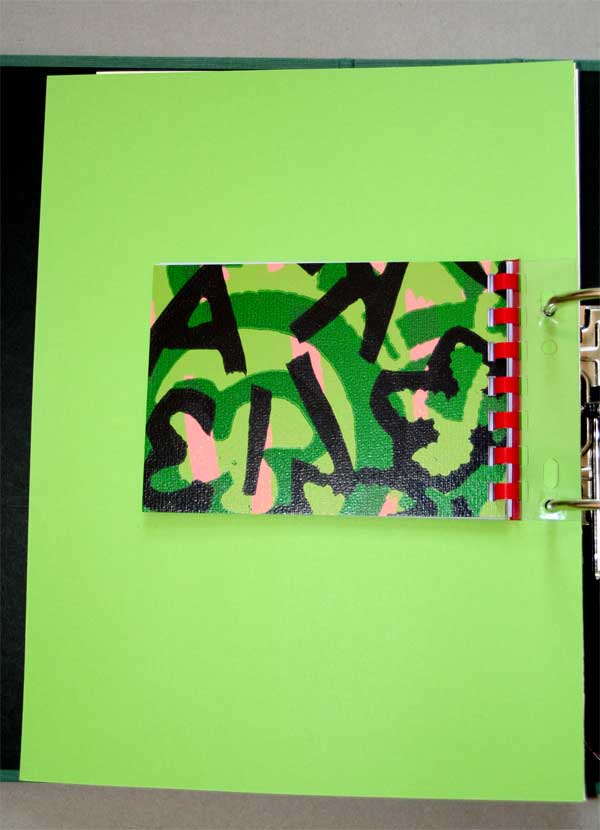
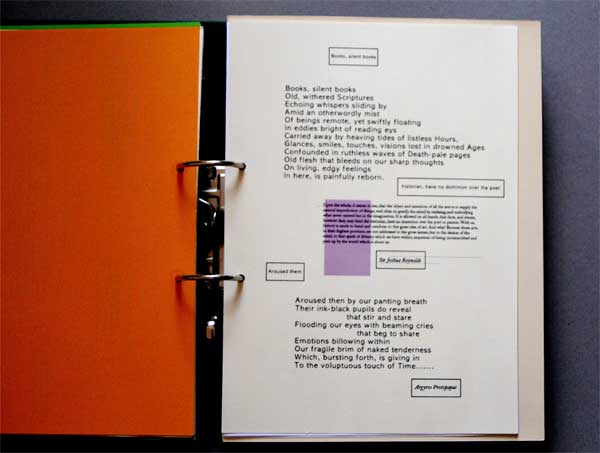
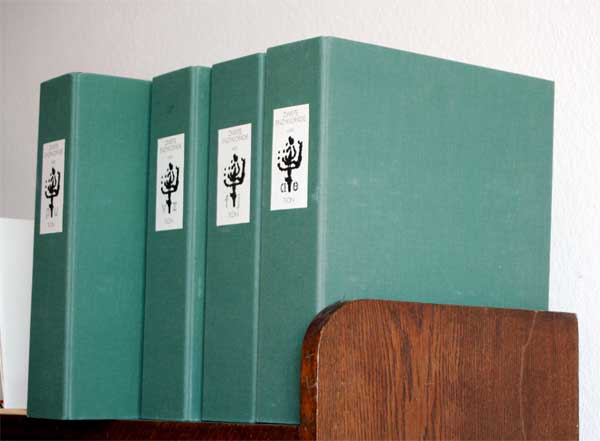
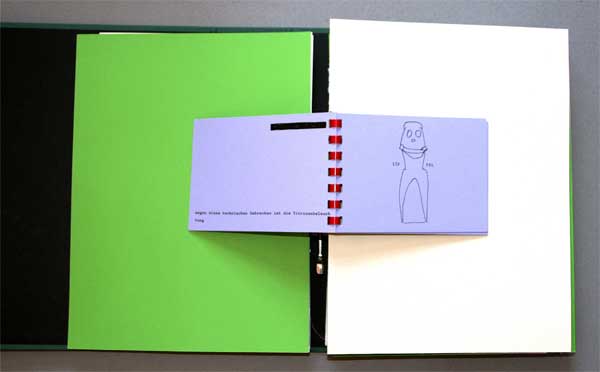
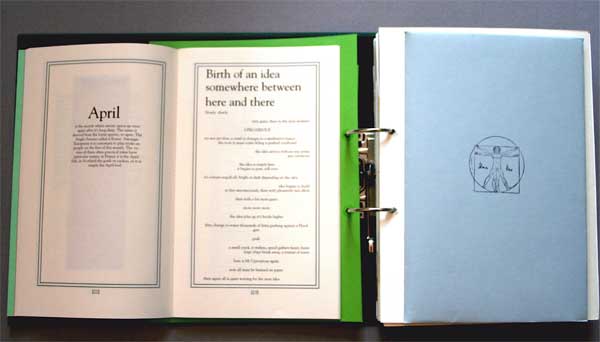
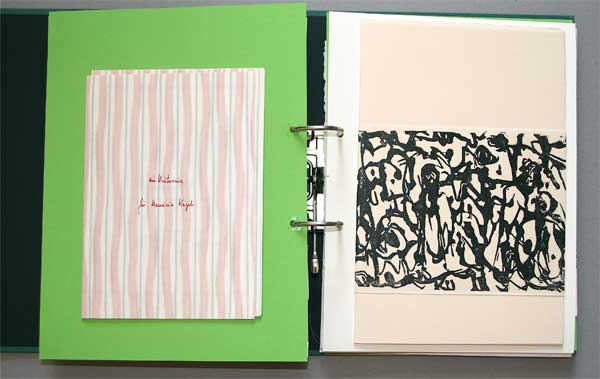
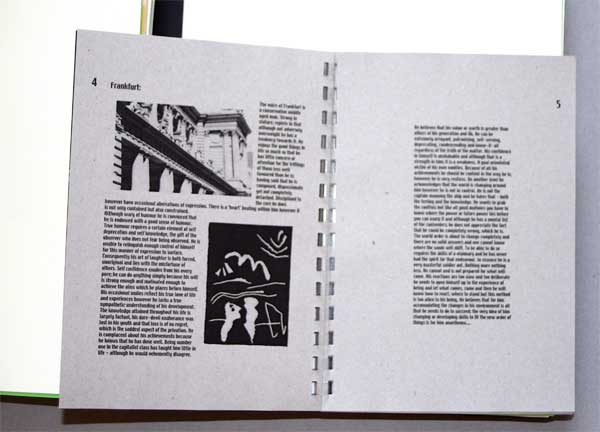
Independently Published in Memphis, Tennessee, 1824-1914.
A masterpiece of philosophical apocrypha, the First Encyclopaedia of Tlön is the clandestine work of a secret society of scholars, philosophers, scientists, artists, and writers who dedicated themselves to the awesome task of inventing an entire planet. Inspired by the seventeenth-century writer J.V. André, who coined the name "Tlön" to describe an imaginary realm, the project was instigated by the American millionaire Ezra Buckley, who wanted to "prove to a nonexistent God that mortals could conceive and shape a world." Published in English over a period of ninety years, the 40-volume Encyclopaedia was limited to a run of 300 copies, intended to be distributed only to members of the society and a few select "friends." The whole set is reputed to consist of forty octavo volumes, each with 1001 pages bound in yellow leather, and filled with color engravings, drawings, and diagrams. Each volume -- quite mysteriously -- bears no signs of origin or date, except for the inscription "ORBIS TERTIUS" in a blue oval stamp on a silk sheet covering the illustrated title page. According to some reports, Volume XL is said to contain an extensive index; but this was denied in an anonymous letter sent to the 1920 MLA Convention, carefully typed on white paper with the blue oval stamp as a signiture. (Postmarked from Brazil, the letter contained a photograph of a page numbered 998 and detailing the "Zynemorg," a typographical symbol used to represent the various degrees of belief an author has in a word or statement.)
Often considered to be among the world's rarest books, all extant volumes of the Encyclopaedia are believed to rest exclusively in the hands of private collectors. Indeed, so rarely does a volume make an appearance, more than a few bibliophiles have declared the entire project to be as apocryphal as Tlön itself. This confusion is only made worse by persistent hoaxes and spurious fragments, such as the Thessaloniki Manuscripts, Sean Kernan's faux set of "Early Plates on the Morphology of Insects of the Axa Delta," Markus Fahrner's Zweite Enzyklopädie von Tlön, and of course the recently "unearthed" Volume IX, sold for an undisclosed sum over the Internet and unmasked as a hoax by Laura Barnes of Glenn Horowitz Booksellers. (Who, by the way, are rumored to be in possession of no less than six complete genuine sets!) Aside from these various forgeries and imitations are the many outlandish claims and conspiracy theories put forth by so-called Tlönists. (For a complete listing of Tlönist stories, fakes, and forgeries, see Suzanne Nixon's "A Con's-Piracy of Sirens," Spiral-Bound, No. 13, Fall 1999, pp 23-34. A personal favorite of mine is Trevor Ravenscroft's contention that over half the 300 sets were sunk with the Lusitania in 1915; apparently Kapit‰nleutnant Walther Schwieger of U-20 had misunderstood his orders to "retrieve" the shipment of volumes for some dire cabal of Germans!)
Of course, this sense of mystery only increases the fascination the First Encyclopaedia of Tlön holds for artists and writers alike. The Encyclopaedia is the subject of numerous stories and artistic projects, including Richard Behrens' novel U-20, Mark Gustavson's 11-movement symphony Eleven Hrönir, and of course, Borges' celebrated short story "Tlön, Uqbar, Orbis Tertius," in which the world of Tlön slowly consumes our own reality. Although most biographers agree that a copy of Volume XI was once in the possession of Borges, it has never been discovered, leading many to believe that it was tragically misplaced or even stolen. More than a few, however, including both Willis Barnstone and Ivan Almeida, have rather quixotically suggested that it was actually given as a present to Adolfo Bioy-Casares, whose "flawed" copy of The Anglo-American Cyclopedia was used as the fictional germ for Borges' original story. Their evidence for this is unfortunately slim -- a brief mention in conversation with Borges' first wife of a letter from Bioy-Casares; this letter, however, was apparently lost during the second PerÛn regime, and like so many other things involving Tlön, its existence is generally considered apocryphal. (See Traces & Letters: Early Notebooks of Borges, edited by Willis Barnstone, 1975, published by New Horizons after Borges' death in 1986.) But whether or not Bioy-Casares ever saw a volume of the First Encyclopaedia of Tlön, his actual copy of Volume XLVI of The Anglo-American Cyclopedia can be viewed in the Buenos Aires Writer's Museum. Its black leather binding and faux gold leaf trim seem to leap right from the pages of Ficciones, serving to remind us of the unique way Borges viewed the interchangeable nature of reality and fictive illusion.
And yet, and yet.... Perhaps one of the strangest theories about Borges and the Encyclopaedia predictably comes from Umberto Eco. In an article in PoMo Praxis (June 1988, pp. 34-36) the Italian semiologist speculates, tongue somewhat in cheek, that Borges himself was actually a late member of the secret society responsible for the First Encyclopaedia of Tlön, a circle which included his granduncle, Silas Haslam. Recruited by Xul Solar in the years following its publication, Borges' principle assignment was to write a story about himself finding Volume XI -- a trick designed to make any rogue copies of the Encyclopaedia seem to be the work of a Borges imitator, and consequentially completely fictional. Eco also ventures that NÈstor Ibarra's "now classic" refutation of the Tlön project in the Nouvelle Revue FranÁaise was ghost-written by Borges, who permitted his friend Ibarra to believe it was just another literary joke.
Lesbare und lesenswerthe Bemerkungen ¸ber das Land Ukkbar in Klein-Asien
Johann Valentin Andre‰
Strassburg, Lazarus Zetzner, 1641.
A very rare work of which only seven original copies survive, this fictional travelogue was written by J.V. Andre‰, the purported author of Chymische Hochzeit Christiani Rosencreuz and "accidental" founder of the Rosicrucian movement. Author of several works involving imaginary communities and mystico-Christian utopias, including the Reipublicae Christianopolitanae Descriptio, Bemerkungen was an expansion of ideas first expressed in the Christianopolis, now projected onto an abstract philosophical country situated within the borders of present-day Iraq. While certainly of interest to Borges scholars and modern Rosicrucians, Bemerkungen is most notorious for its chapter on the ideal community of Vheissu, the major inspiration behind the infamous Zweite Fruchtbringende Gesellschaft. Better known to history as the Commune of Prague, the ZFG was an isolated group of philosophers, Rosicrucians, and Lutheran radicals who attempted to recreate the ideals of Vheissu by establishing a closed community outside Prague in 1773. Their experiment was a disaster, ending two years later in a spiral of cannibalism, violent orgies, and mass suicide. (For further details, see "Rosiges Gl¸hen, Blutiges Kreuz," by Kristoph Gross, Der Annalen Metakarus, 1934, pp. 345-78; or "The Prague Commune and its Influence on DeSade's The 120 Days of Sodom," by Josephine Pinto, Lingua Franca, Vol 10/No. 3, April 2000, pp. 22-25.)
Bemerkungen is not an easy work to read, filled with arcane references to the Qabalah, idiosyncratic prose structure, and bizarre, almost absent-minded lapses into Latin. Most difficult of all are the numerous German terms and compound-expressions, many of which were specially coined by Andre‰ to describe the philosophy of Uqbar and its fantastic literary realms of Mle'khnas and Tlön. (To provide two of my favorite examples: Ketherursprache, which means "the primal (pre)language of fire and creation," and Ding-nicht-Ding, an expression nearly anticipating Kant, used to represent "an object that is simultaneously there and not yet present.") Despite the tortuous prose and abstract philosophical formulations, there is an amusing satiric slant to the work, and once in a while it even topples over into genuine comedy. In fact, the entire section devoted to the Heresiarchs of Uqbar -- which informed the encyclopedia entry famously misquoted by Bioy-Casares in Borges' "Tlön, Uqbar, Orbis Tertius" -- takes the form of a comical debate between duelling philosophers, and parodies Plato's Republic with surprising wit. (Kathryn Hume once jokingly referred to the book at "The work of a seventeenth-century Pynchon." Given that Thomas Pynchon uses "Vheissu" to describe a mythical land in V., it is certainly plausible that he was familiar with Andre‰. See Hume's study, Pynchon's Mythography, Southern Illinois University Press, 1987.)
The history of translating Bemerkungen is almost as convoluted as its style. Poorly translated into French in 1783 by an anonymous Freemason, this flawed version was subsequently rendered into English in 1817 by Immanuel St. James, an associate of De Quincey, who first introduced De Quincey to Andre‰'s work. No great linguist himself, St. James introduced countless additional errors to his Clear and Worthy Observations on Uqbar of Asia Minor, further diluting the humor and complexity of Andre‰'s original. Silas Haslam was working on a more authentic English translation based directly on the German text at the time of his death in 1914, but literary legend contends that his wife Anna burned the manuscripts. Seven years later, the 1641 text was updated into modern German by Catholic theologian and historian Kristoph Gross. Using Gross' new German edition, the book was finally translated into modern English in 1990 by Markus Fahrner. Titled A Few Literary Remarks Regarding Uqbar of Asia Minor, this version is now published by Phranes Press, with an introduction and annotations by Rosicrucian scholar Adam McLean.
History of a Land called Uqbar
Silas Haslam
Ippwich & Beckett, London, 1874
This book is remarkable for several reasons. Not only is it the first work penned by the inimitable poet and historian Silas Haslam, but it could very well mark the beginning of a literary heritage which came to full flower in Jorge Luis Borges -- Silas Haslam was the younger brother of Frances Haslam, Borges' paternal grandmother. In many ways, Haslam was a precursor to his grandnephew, bestowing upon him a love of mazes, wordplay, and, unfortunately, blindness.
In true "Borgesian" fashion, Haslam's first book is a fictional history of an imaginary place, the philosophical utopia created over two centuries earlier by J.V. Andre‰. While living in Berlin with German cousins, the young poet was introduced to Andre‰'s Lesbare und lesenswerthe Bemerkungen ¸ber das Land Ukkbar in Klein-Asien by Jacquelyn Lindhurst, an American artist and occultist who was working on a series of illustrations for an Andre‰ Compendium. Fluent in German and possessing a rare copy of the original text, Lindhurst shared her delight in Andre‰ with the young poet, who eventually moved into her studio as their relationship developed along more intimate lines. Utterly enchanted by the very notion of "Ukkbar," Haslam acquired both the Masonic French and St. James English translations of Bemerkungen, slowly working through the original text with the help of Lindhurst. His imagination fired, he began recreating his own version of Uqbar, expanding it and adding his sense of poetic grandeur to Andre‰'s complex philosophical games.
Often compared to Swift's Gulliver's Travels, The History is a brilliantly inventive book, clearly displaying the eccentric black humor and linguistic playfulness that would later become Haslam's trademark. In chronicling Uqbar's countless wars and religious persecutions, Haslam created his own "stone mirror," creating a dark and sharply polished reflection of the European forces of imperialism, colonialism, and religious intolerance that he would later satirize openly in his epic poems. As would be expected of the author of such labyrinthine works as Gannymeade & Europa and Love Song for a Minotaur, Haslam describes the philosophies of Uqbar with meticulous detail, spinning the threads of multiple nuance into an expanding web of complexities that engage and entangle the reader on every page. Unlike Andre‰, Haslam surprisingly avoids exploring the languages of Uqbar; but his fabrications and explanations of its strange cults and endless rituals mark a profound insight into the pyschology of "modern man," and his ability to parody the rivalries of subtly differing systems of thought remains unparalleled.
Unfortunately, the Andre‰ Compendium never materialized, and after Lindhurst drifted into Theosophy, Haslam moved to Vienna where he met and eventually married the artist Anna Mondaugen, the "muse" to whom he would dedicated the rest of his work. In 1967, Haslam's biographer, A. Buell Rooke, discovered thirteen of Lindhurst's illustrations in the possession of her grandson, a Rosicrucian living in San Jose. Seven of these where subsequently included in the 1974 Grove Press centennial edition of History of a Land Called Uqbar; though the hardcover is now out of print, black-and-white versions of the plates are still included in the Grove Press paperback. Additionally, it should be noted that Haslam's work has generated quite a few books of commentary. By far the most complete analysis is The Hydra Remerges, by Jon Fetter of the Hess Language School in Taiwan, which tracks the "many heads of Uqbar." (1988, San Ming Press.) I would also recommend the section titled "Victorian Postmodern" in Brian McHale's Postmodernist Fiction, Routledge, 1987, pp. 7-9; and of course, Borges' lecture "Haslam and his Mazes," available by reprint from the University of Texas. Although Borges has -- perhaps deliberately -- never discussed the subject, it's almost unthinkable that his father's library would not have held a copy of Haslam's History. From this, Borges would have learned of Andre‰'s text; finally deciding in 1940 to try his own hand at reinventing Uqbar in the pages of Sur. (For details, see my own "Evolving Tlön," by Allen Ruch, Variaciones Borges, No. 1/1996, pp. 121-131.)
Copyright 2001; Allen Ruch